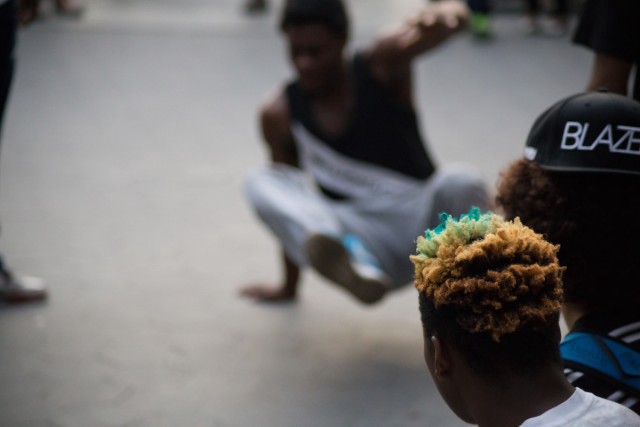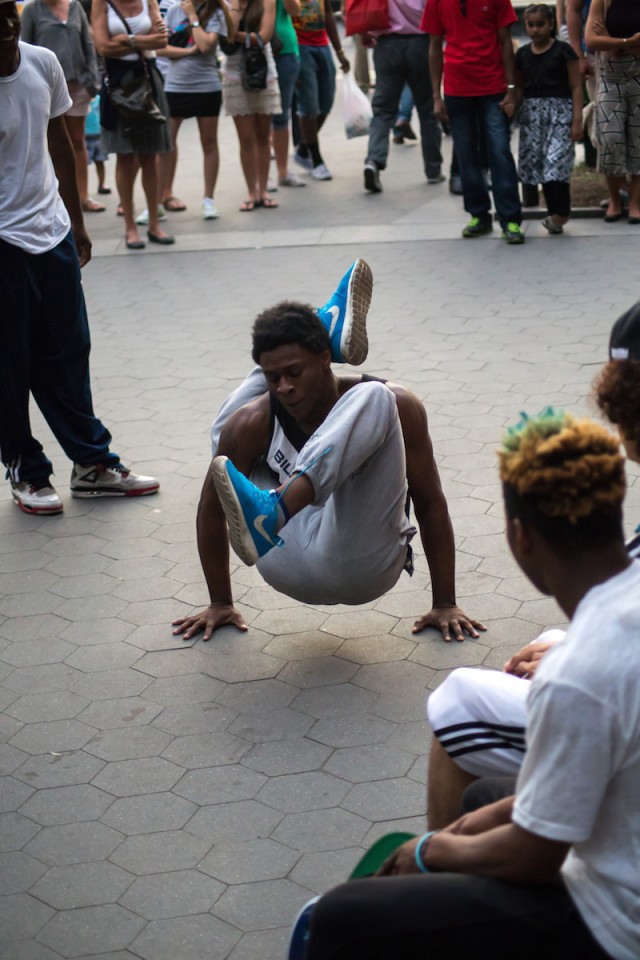It's Showtime
by Kit Dillon

Last summer, on the northwest corner of Union Square, a group of twenty or so black and Latino teenagers had just been kicked out of the McDonald’s for being too loud, shouting orders and messily passing around Extra Value meals. Somebody on the staff got nervous and called the cops. One teen, as he walked out, stopped long enough to show another how to lock an elbow in a dance move before grabbing a handful of his unfinished fries.
“She’s alright,” Goofy, the nineteen-year-old leader of the group, a dance team that calls itself W.A.F.F.L.E or We Are Family For Life Entertainment, said of the security officer. “Everyone has a job to do. I try to tell the team that — you know, to be respectful. You gotta be aware of how people see you.” In front of new people, Goofy talks quietly and keeps his eyes pointed towards the ground, glancing up only to see if he has been understood. Goofy is around five feet, eight inches tall, and the sinewy quality of his muscles, toned by constant dancing, was apparent beneath his loose-fit shirt, while a polychromatic spray of colors faded in and out across his scalp.

On some unspoken cue, the kids grabbed their backpacks, spare shoes and a portable speaker, and started moving south toward 14th street in small clusters. Some danced as they moved away from the corner, breaking out into small and practiced routines. “You’re just ruining it for yourselves,” an NYPD officer, standing in front of the restaurant doors, his arms folded across his chest, yelled. Some of the crew, slightly ahead of Goofy, started throwing ice from a half-finished soda cup at the people directly behind him; a retaliatory bombardment passed over his head from the other direction. Most of the chunks, half-melted and slick but sticky with soda, missed their targets and scattered on the street.

“Yo, Stop!” Goofy shouted. The ice salvos ended abruptly. “They be doing crazy stuff,” Goofy said as he shook his head and kept walking, an eye on the kids ahead of him. Two years ago, Goofy put the team together with just a few of his friends, but now he’s responsible for a rotating roster of somewhere between twenty and thirty dancers. He collects the team’s entrance fees for dance competitions; coordinates practice sessions; and designs the team jerseys, which feature everyone’s dance name on the back, like Lil Busy, Case Move, A-Mac, Waffle Crazy, Tootie (the group’s sole female dancer), and Aero-14. “I try to teach them how to handle situations,” he said. “I make mistakes too, but I try to make sure they’re in school, doing well outside of dancing. If one thing don’t work out the other will.”

Six years ago, Goofy was one of the first dancers to walk onto a crowded New York City subway with a few of his friends turn up some music playing from a portable speaker and announce, “What time is it, ladies and gentleman? Showtime!” before launching into a dance routine that few people had seen before. The moves were so new they barely had a name yet — just a funny looking series of steps that a few kids in the parks were starting to call “Litefeet.”
Litefeet’s roots are grounded equally in New York City parks and the internet. Over the course of 2006 and 2007, DJ Webstar released the tracks “Chicken Noodle Soup,” and “Tone Wop” (or “Toe Wop”) and designed some dance steps around them, a series of abrupt close steps, bouncy but compact. Teens spent the summers filming themselves in their bedrooms, high schools and city parks like Slattery Ave and uploaded the results to YouTube. The dancers kept their arm movements pulled in, near their body, with the added occasional signature contortion or body lock; a foot hooked into an elbow and held for a moment in a more dynamic example of something a Park Slope yoga diehard might do during their practice. It was a dance that fit well inside of the cramped frame aspects of closely filming laptop and cell phone cameras.
As both the Chicken Noodle Soup and Tone Wop spread in popularity, dancers began to combine both dances into a single, distinctive style. By tightening up their footwork and inventing steps of their own, the first definitive Litefeet sequence was born: Known as “The Rev-Up,” the dancer lifts his leg and pivots his body before stepping in and out with a forward heel kick and snapping his hands on the last beat. In 2007, dancer Chrybaby Cozie, one of the early innovators of Litefeet, can be seen here at one of DJ Webstar’s 2007 Voice of Harlem parties combining some of Litefeet’s earliest movements into what would later become the The Rev-Up. It was arguably when these moments were uploaded to YouTube that Litefeet was born.
Plenty of artists had come and gone through the New York City subway system before Goofy and his friends stepped onto the trains to dance for the first time. But Litefeet dancers could pull off moves in spaces as small as a few square feet. In the beginning, Goofy and his team kept the routine simple: Rev-Ups into Wave Connects into Lock Ins, which punctuate the end of Litefeet sequences like a period at the end of a sentence. Over time, the shows evolved, and teams began incorporating props and subway handrails to modify and expand their repertoire of moves. Today, a good Lifefeet subway routine includes backflips down the center aisle, hat and shoe tricks — a shoe kicked up over the head of one dancer, caught between the shoulder blades of another — and increasingly difficult acrobatic stunts. Dancers might flip up onto their hands and lock their feet into the subway handrails or lift themselves and twist their bodies, contorting their shoulder and elbow joints before suddenly unwinding towards the floor in a press up or handstand, their bodies inches from commuters’ faces.
On a typical day in 2010, Litefeet teams like W.A.F.F.L.E could earn anywhere between a hundred and three hundred dollars per person in the subway. For two years, it was enough to pay Goofy’s tuition at The Walk In Love Christian Academy in Brooklyn. But their success was easy to see and drew countless imitators, just like the other competing hustles on the subway cars — the human beat boxers, Motown crooners, pint-sized discount candy crews, job-bucket drum soloists and high school basketball team collection runners. Lesser crews began to saturate the market, turning a show that you were lucky to see once a week into a daily or even hourly occurrence. “For a little while,” Mo’Black, Goofy’s close friend and fellow dancer told me, “The L was good. The A train people, they know the culture already. They was like the Soul Train. They get into it. But you couldn’t make as much as you could with the Q. Then a lot of people started coming out with no skill, complaining that they can’t get cash anymore. Now they’ll say it’s not whack. But I know it’s whack. Your show is whack!”
By the summer of 2013 Litefeet in subway cars had reached a breaking point. For some commuters, every ride to and from work became “showtime!” Complaints and reports of fights and violence initiated by the dancers mounted. “Some people, I don’t know, they weren’t raised right,” Goofy said. “They go on the trains being rude and yelling at people, it makes us all look bad. It’s like going to a real job disrespecting your boss and expecting to get paid.” In one incident reported to the NYPD, a commuter was slapped. It was enough to get new Police Commissioner Bill Bratton on TV, warning that crews like W.A.F.F.L.E spread a sense of fear and threatened subway safety. It presaged a crackdown, with plainclothes officers arresting nearly a hundred dancers since the beginning of January, and charging half of them with the Class A misdemeanor of reckless endangerment.

As W.A.F.FL.E. made its way to Washington Square Park, someone turned on the portable speaker, a plastic blue Behringer stereo amp that has become a staple of the scene: even though it doesn’t seem to be for sale anywhere, it’s in the hands of dance kids everywhere. Shaped like an oversized dustbuster with a built-in speaker/aux input, the unit hides a pair of powerful speakers behind a single grey plastic grill. The speakers spat out “Keep It Stacc,” a hypnotic, looping new piece from sixteen-year-old producer Lil’ Live. Like most of Litefeet’s music, the song is organized around a few simple loops and oddly pitched-up vocal stabs. It’s distinct, unpolished. With a heavy bass line and a hynoptic melody, Keep It Stacc is popular among the members of W.A.F.F.L.E. “Fire,” remarks A-Mac. The others nod their heads in agreement.

While on the subways it’s rare for groups to get larger than four to six dancers, in a park, an entire team can dance and cheer each other on. The dancers formed into a circle in one small area of the park, with different members of the team stepping in for a minute or so and showing off a few steps before ceding the floor to the next dancer. Soon, a wide circle of around a hundred and fifty passersby formed around W.A.F.F.L.E, most holding iPhones, iPads, and digital cameras as Goofy walked around the perimeter, handing out business cards.
Mo’Black stepped into the middle of them and rolls through his own version of the Rev-Up, laying down a string of moves before grabbing the hat from his head and throwing it in the air while lightly bending back into a sweeping leg flip. The hat arced over his body as his legs came around underneath him, and as the last beat landed, the entire group stamped the ground while the hat, previously framed mid-air, landed back on Mo’Black’s head, his hands shooting out to the right with a snap.
When the music stopped, the crew fanned out trying to collect some cash for their efforts. But the crowd dissipated even abruptly than it had formed. “We’ve made about two dollars each,” Mo’Black laughed while wiping the sweat from his face. “New York is not a place where people want to see you go far,” Goofy said. “Everyone trying to get there first. But there are always new people coming in. There will always be somebody new to dance for.”
Kit Dillon is a writer, among other things, in New York City.
All photos, except the triptych, by Mario Scarpaci
